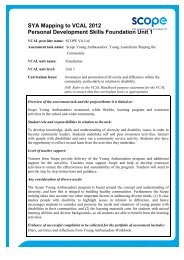Positive behaviour support Getting it right from the start
Positive behaviour support Getting it right from the start
Positive behaviour support Getting it right from the start
You also want an ePaper? Increase the reach of your titles
YUMPU automatically turns print PDFs into web optimized ePapers that Google loves.
54 <strong>Pos<strong>it</strong>ive</strong> <strong>behaviour</strong> <strong>support</strong>: <strong>Getting</strong> <strong>it</strong> <strong>right</strong> <strong>from</strong> <strong>the</strong> <strong>start</strong> - Facil<strong>it</strong>ators reference manual<br />
PowerPoint 74<br />
*<br />
Individually list examples of how and why you communicated today.<br />
As a group identify <strong>the</strong> how and why <strong>the</strong> person you <strong>support</strong> communicated on your<br />
last shift.<br />
Are <strong>the</strong>y different and why?<br />
PowerPoint 75<br />
*<br />
About <strong>behaviour</strong>s of concern<br />
Between five and 15 per cent of people w<strong>it</strong>h an intellectual disabil<strong>it</strong>y show <strong>behaviour</strong>s of<br />
concern which can present a significant challenge to both <strong>the</strong> person and those involved in<br />
providing <strong>support</strong>.<br />
Of <strong>the</strong>se only between two and 20 per cent of people in need of pos<strong>it</strong>ive <strong>behaviour</strong> <strong>support</strong>,<br />
actually receive any kind of <strong>behaviour</strong>al <strong>support</strong>. Fifty to 60 per cent of people w<strong>it</strong>h a disabil<strong>it</strong>y<br />
showing <strong>behaviour</strong>s of concern will be subject to <strong>the</strong> restrictive intervention of chemical<br />
restraint, which is psychotropic medication, typically antipsychotics, used for <strong>the</strong> primary<br />
purpose of <strong>behaviour</strong>al control.<br />
Behaviours of concern can be defined as:<br />
‘…<strong>behaviour</strong> of such intens<strong>it</strong>y, frequency and duration that <strong>the</strong> physical safety of <strong>the</strong> person<br />
or o<strong>the</strong>rs is placed or is likely to be placed in serious jeopardy, or <strong>behaviour</strong> which is likely<br />
to seriously lim<strong>it</strong> use of, or result in <strong>the</strong> person being denied access to ordinary commun<strong>it</strong>y<br />
facil<strong>it</strong>ies, services and experiences’. Emerson 1995<br />
Examples include:<br />
• aggressive <strong>behaviour</strong><br />
• self-injurious <strong>behaviour</strong><br />
• property destruction<br />
• fire lighting<br />
• w<strong>it</strong>hdrawn <strong>behaviour</strong>.<br />
The term ‘<strong>behaviour</strong>s of concern’ implies that a higher standard and qual<strong>it</strong>y of services is<br />
required than those ordinarily provided to people w<strong>it</strong>h an intellectual disabil<strong>it</strong>y. The <strong>behaviour</strong>s<br />
that <strong>the</strong> term covers set a challenge to services to improve <strong>the</strong> way <strong>the</strong>y do things. The term<br />
was first used to encourage service providers and <strong>the</strong> commun<strong>it</strong>y to develop better services,<br />
<strong>support</strong>s and att<strong>it</strong>udes to address <strong>the</strong> <strong>behaviour</strong>al difficulties demonstrated by some people w<strong>it</strong>h<br />
a disabil<strong>it</strong>y. (Toogood, Bell, Jacques, Lewis, Sinclair and W<strong>right</strong>, 1994).

















